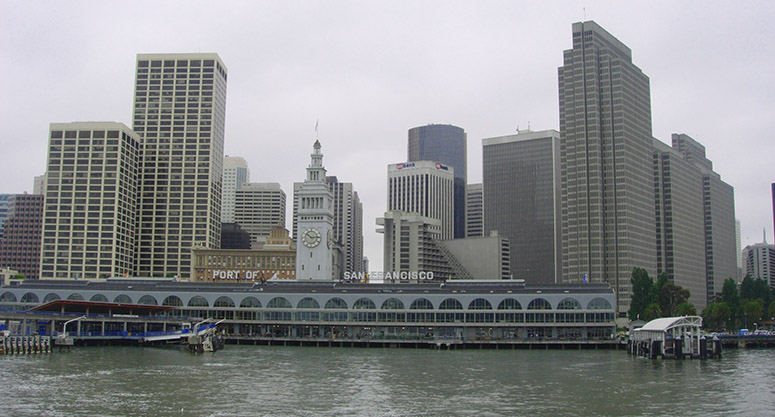A broad coalition of shippers and other supply chain stakeholders are appealing to West Coast dockside labor and management to begin early discussions on either a contract extension or a new contract, with the goal of successfully concluding negotiations before the current contract expires on June 30, 2019.

San Francisco is focused on assembling a long-term municipal financing plan for its coastal seawall, which protects a densely developed downtown core. Photo by Joel Williams
By Patrick Burnson
Published: April, 2016
A broad coalition of shippers and other supply chain stakeholders are appealing to West Coast dockside labor and management to begin early discussions on either a contract extension or a new contract, with the goal of successfully concluding negotiations before the current contract expires on June 30, 2019.
In a public letter to both Robert McEllrath, president of the International Longshore and Warehouse Union, and James McKenna, chairman and CEO of the Pacific Maritime Association, the coalition is urging labor and management to avoid a repeat of the disruptions and slowdowns that occurred during the 2014 contract negotiations.
“We are encouraged by your remarks at a recent shipping conference, and are pleased that you recognize the negative economic impact of disruptions and slowdowns,” stated the group consisting of manufacturers, farmers and agribusinesses, wholesalers, retailers, importers, exporters, distributors, transportation and logistics providers.
“We also know there will be important and difficult issues for both of you to resolve during the next set of negotiations. All the more reason, we believe, for those talks to begin as early as possible in order to lay the groundwork for a new contract, or contract extension, without major disruption.”
These shippers believe a new model for future negotiations needs to be developed—one which stresses early and continuous dialogue. In addition, they would like to see both labor and management avoid actions that would slow, stop or disrupt cargo movement during negotiations.
“At a minimum, we urge you to maintain the arbitration mechanisms in the existing contract for the duration of the negotiations, even if the contract expires before a final agreement is reached,” said the group.
As chronicled in this column, the impact of cargo disruptions during the 2014 negotiations was widespread and affected logistics managers sourcing from and shipping to ports throughout the United States. The costs were enormously high for many economic sectors. A repeat of this event could be catastrophic. Furthermore, the stakes could be heightened next time as megavessels are now being deployed all along the coast and ocean carriers are increasing their reliance on Pacific Rim supply chains.
Agreeing early to a long-term contract will provide the stability and predictability these shippers need, while protecting against any self-inflicted harm to the broader U.S. economy. Also, maintaining arbitration procedures during negotiations will give a measure of certainty to the cargo interests of the ultimate end user, the shippers.
S.F. Seawall Needs Fortification
According to Elaine Forbes, interim director of the Port of San Francisco, the city faces “an intergenerational, multi-billion-dollar investment need to fortify the seawall, a critical yet largely unseen piece of the city’s infrastructure.”
San Francisco is focused on assembling a long-term municipal financing plan for its coastal seawall, which protects a densely developed downtown core. Understanding that this will be a multi-generational project, city officials are most interested in conceptualizing a budgeting and public engagement strategy that can endure a near-term change in administrations as well as sustain public support 10, 20 and 30 years from today and beyond.
As cities around the world begin to reconcile the very real and unpredictable consequences of sea level rise and increased seismic vulnerability, San Francisco is looking to draw upon the City Accelerator to explore innovative financing options to fund seawall upgrades now and ongoing maintenance costs over several decades.
“An estimated up to $5 billion is needed for the overall long-term Seawall Resiliency Project to provide a stable and adaptable foundation to address sea level rise and an estimated $500 million to address immediate life safety improvements to the infrastructure,” said Forbes.
The seawall has a long history of enabling development in San Francisco; the construction of stable piers and viable landings for the shipping industry laid the infrastructural foundation for the city’s thriving maritime economy through the first half of the twentieth century.
Construction of the seawall began in 1878, prior to the development of modern engineering techniques that account for seismic risks and liquefaction. A major earthquake would likely cause major damage and disruption to the Seawall if it is not upgraded and maintained.
PTA Lunch Welcomes Mayor Brown
The Pacific Transportation Association staged its first “Leadership Luncheon” last month with featured speaker Willie J. Brown Jr., who told Bay Area shippers that creating a “world-class waterfront” requires “the art of politics and persuasion.” Having had a distinguished career as a two-time mayor and as Speaker of the California Assembly, Brown now heads up the Institute on Politics and Public Service.
Patrick Burnson is the past president and current board member of the Pacific Transportation Association, based in San Francisco. www.pacifictrans.org

